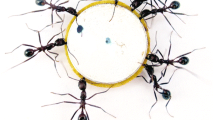Summary:
A mechanism for co-operative load transport was detected in the seed-harvesting ant Messor barbarus. Workers co-operated sequentially, transferring the load from one to another and thus forming what might be termed a transport chain. Although most of the colony's workers could have transported loads unaided, co-operation was prompted by the appearance of high loading ratios in the vicinity of the food source. The first worker in such a chain tended to be small or medium-sized, with a high loading ratio, while the last was larger, and had a correspondingly lower loading ratio. This strategy was of major benefit to the colony, in that it considerably reduced the time required for transport to the nest.
Similar content being viewed by others
Author information
Authors and Affiliations
Additional information
Received 10 June 1997; revised 14 May 1998; accepted 25 May 1998.
Rights and permissions
About this article
Cite this article
Reyes, J., Fernández Haeger, J. Sequential co-operative load transport in the seed-harvesting ant Messor barbarus. Insectes soc. 46, 119–125 (1999). https://doi.org/10.1007/s000400050121
Issue Date:
DOI: https://doi.org/10.1007/s000400050121




